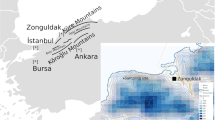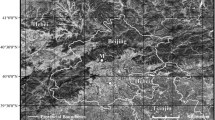Abstract
Early peaks of airborne ragweed (Ambrosia L.) pollen concentrations were observed at several monitoring stations in Hungary in June 2017 and 2018, one month before the usual start of the pollen season at the end of July. Backward trajectories were calculated to simulate potential sources of pollen collected at different locations in the Pannonian Biogeographical Region. In a collaboration between aerobiological and phenological networks, a nationwide campaign was conducted to collect field data of ragweed blooming. During field surveys, ragweed plants having extremely early blooming were found most abundantly in a rural site near Vaja (North-East Hungary) and other locations in Hungary. Field observations matched with source areas identified by trajectory analyses; i.e., early-flowering ragweed plants were found at some of these locations. Although similar peaks of airborne pollen concentrations were not detected in other years (e.g., 2016, 2019–2021), alarming results suggest the possibility of expanding seasons of ragweed allergy.




Similar content being viewed by others
References
Afonin AN, Fedorova YA, Li YS (2019) Characterization of the occurrence and abundance of the common ragweed (Ambrosia artemisiifolia L.) with regard to assessment of its expansion potential in European Russia. Russ J Biol Invasions 10(3):220–226. https://doi.org/10.1134/S2075111719030032
Apatini D, Magyar D, Novák E, Páldy A (2009) Ragweed (Ambrosia artemisiifolia L.) pollen seasons in Hungary (1992–2008), descriptive results using the database of the Hungarian Aerobiological Network. Növényvédelem 45(8):449–453
Béres I (2004) Integrated weed management strategies against ragweed (Ambrosia artemisiifolia L.). Magyar Gyomkutatás És Technológia 5:3–14
Béres I, Bíró K (1993) Life cycle and duration of phenophases of ragweed (Ambrosia elatior L.). Növényvédelem 29:148–151
Bieker VC, Battlay P, Petersen B, Sun X, Wilson J, Brealey JC, Bretagnolle F, Nurkowski K, Lee C, Owens GL, Lee JY, Kellner FL, van Boheeman L, Gopalakrishnan S, Gaudeul M, Mueller-Schaerer H, Karrer G, Chauvel B, Sun Y, Dalen L, Poczai P, Rieseberg LH, Gilbert MTP, Hodgins KA, Martin MD (2022) Uncovering the hologenomic basis of an extraordinary plant invasion. BioRxiv. https://doi.org/10.1101/2022.02.03.478494
Chauvel B, Martinez Q, Guillemin JP (2012) Importance of seeds in the process of common ragweed invasion. Current Trends in Plant Protection Proceedings https://www.cabi.org/isc/FullTextPDF/2013/20133296736.pdf Accessed 14 February 2022
Cecchi L, Morabito M, Domeneghetti P, Crisci MA, Onorari M, Orlandini S (2006) Long distance transport of ragweed pollen as a potential cause of allergy in central Italy. Ann Allergy Asthma Immunol 96(1):86–91. https://doi.org/10.1016/s1081-1206(10)61045-9
Csépe Z, Leelőssy Á, Mányoki G, Kajtor-Apaini D, Udvardy O, Péter B, Páldy A, Gelybó G, Szigeti T, Pándics T, Kofol-Seliger A, Simčič A, Leru PM, Eftimie A-M, Šikoparija B, Radišić P, Stjepanović B, Hrga I, Večenaj A, Vucić A, PerošPucar D, Škorić T, Ščevková J, Kmenta M, Berger U, Magyar D (2019) The application of a neural network-based ragweed pollen forecast by the Ragweed Pollen Alarm System in the Pannonian Biogeographical Region. Aerobiologia 36:131–140. https://doi.org/10.1007/s10453-019-09615-w
Deen W, Swanton CJ, Hunt LA (2001) A mechanistic growth and development model of common ragweed. Weed Sci 49:723–731. https://doi.org/10.1614/0043-1745(2001)049[0723:AMGADM]2.0.CO;2
deWeger LA, Pashley CH, Šikoparija B, Skjøth CA, Kasprzyk I, Grewling Ł, Thibaudon M, Magyar D, Smith M (2016) The long distance transport of airborne Ambrosia pollen to the UK and the Netherlands from Central and south Europe. Int J Biometeorol 60(12):1829–1839. https://doi.org/10.1007/s00484-016-1170-7
Galán C, Smith M, Thibaudon M, Frenguelli G, Oteros J, Gehrig R, Berger U, Clot B, Brandao R (2014) Pollen monitoring: minimum requirements and reproducibility of analysis. Aerobiologia 30(4):385–395. https://doi.org/10.1007/s10453-014-9335-5
Grewling Ł, Bogawski P, Smith M (2016) Pollen nightmare: elevated airborne pollen levels at night. Aerobiologia 32(4):725–728. https://doi.org/10.1007/s10453-016-9441-7
Grewling Ł, Bogawski P, Kryza M, Magyar D, Šikoparija B, Skjøth CA, Udvardy O, Werner M, Smith M (2019) Concomitant occurrence of anthropogenic air pollutants, mineral dust and fungal spores during long-distance transport of ragweed pollen. Environ Pollut 254:e112948. https://doi.org/10.1016/j.envpol.2019.07.116
Hirst JM (1952) An automatic volumetric spore trap. Ann Appl Biol 39(2):257–265
Jato V, Rodríguez-Rajo FJ, Alcázar P, De Nuntiis P, Galán C, Mandrioli P (2006) May the definition of pollen season influence aerobiological results? Aerobiologia 22(1):13. https://doi.org/10.1007/s10453-005-9011-x
Juhász L (1963) Ambrosia species in Hungary. Acta Academiae Paedagogicae Agriensis 1:225–227
Karrer (2011) Spreading, population biology and management of the allergic alien ragweed – causes for the actual spreading and control options. Project Report, Page 229. https://dafne.at/projekte/ragweed Accessed 30. 5. 2022.
Kazinczi G, Novák R (2014) Integrated methods for suppression of ragweed. National Food Chain Safety Office, Budapest, pp 1–226
Kralemann LE, Scalone R, Andersson L, Hennig L (2018) North European invasion by common ragweed is associated with early flowering and dominant changes in FT/TFL1 expression. J Exp Bot 69(10):2647–2658. https://doi.org/10.1093/jxb/ery100
Leelőssy Á, Mészáros R, Kovács A, Lagzi I, Kovács T (2017) Numerical simulations of atmospheric dispersion of iodine-131 by different models. PLoS One 12(2):e0172312. https://doi.org/10.1371/journal.pone.0172312
Lin JC, Gerbig C, Wofsy SC, Andrews AE, Daube BC, Davis KJ, Grainger CA (2003) A near-field tool for simulating the upstream influence of atmospheric observations: the Stochastic Time-Inverted Lagrangian Transport (STILT) model. J Geophys Res: Atmoshttps://doi.org/10.1029/2002JD003161
Márk Z, Bikov A, Gálffy G (2016) Characterisctics of ragweed allergy in Hungary. Orv Hetil 157(50):1989–1993. https://doi.org/10.1556/650.2016.30615
McGoey BV, Hodgins KA, Stinchcombe JR (2020) Parallel flowering time clines in native and introduced ragweed populations are likely due to adaptation. Ecol Evol 10(11):4595–4608. https://doi.org/10.1002/ece3.6163
Meier U (2001) Growth stages of mono- and dicotyledonous plants. BBCH monograph, 2nd edn. German Federal Biological Research Centre for Agriculture and Forestry, Berlin, pp 1–204
NOAA (2015) NCEP GDAS/FNL 0.25 Degree Global Tropospheric Analyses and Forecast Grids. Research Data Archive at the National Center for Atmospheric Research, Computational and Information Systems Laboratory, Boulder, CO. https://doi.org/10.5065/D65Q4T4Z. Accessed 25 Aug 2021
Novák R, Karamán J, Kazinczi G, Somodi I, Csecserits A, Kovács A et al (2014) The spreading of common ragweed. In: Kazinczi G, Novák R (eds) Integrated methods for suppression of common ragweed. National Food Chain Safety Office, Budapest, pp 31–48
Prank M, Chapman DS, Bullock JM, Belmonte J, Berger U, Dahl A, Jäger S, Kovtunenko I, Magyar D, Niemelä S, Rantio-Lehtimäki A, Rodinkova V, Sauliene I, Severova E, Šikoparija B, Sofiev M (2013) An operational model for forecasting ragweed pollen release and dispersion in Europe. Agricl for Meteorol 182:43–53
Raynor GS, Ogden EC, Hayes JV (1970) Dispersion and deposition of ragweed pollen from experimental sources. J Appl Meteorol 9:885–895. https://doi.org/10.1175/1520-0450(1970)009%3c0885:DADORP%3e2.0.CO;2
Saikkonen K, Kari Taulavuori K, Hyvönen T, Gundel PE, Hamilton CE, Vänninen I et al (2012) Climate change-driven species’ range shifts filtered by photoperiodism. Nat Clim Chang 2:239–242. https://doi.org/10.1038/nclimate1430
Scalone R, Lemke A, Štefanić E, Kolseth AK, Rašić S, Andersson L (2016) Phenological variation in Ambrosia artemisiifolia L. facilitates near future establishment at northern latitudes. PLoS One 11(11):e0166510. https://doi.org/10.1371/journal.pone.0166510
Schaffner U, Steinbach S, Sun Y, Skjøth CA, de Weger LA, Lommen ST, Augustinus BA, Bonini M, Karrer G, Šikoparija B, Thibaudon M, Müller-Schärer H (2020) Biological weed control to relieve millions from Ambrosia allergies in Europe. Nat Commun 11(1):1–7. https://doi.org/10.1038/s41467-020-15586-1
Šikoparija B, Skjøth C, Kübler KA, Dahl Å, Sommer J, Radišić P, Smith M (2013) A mechanism for long distance transport of Ambrosia pollen from the Pannonian Plain. Agric for Meteorol 180:112–117. https://doi.org/10.1016/j.agrformet.2013.05.014
Smith M, Skjøth CA, Myszkowska D, Uruska A, Puc M, Stach A, Balwierz Z, Chlopek K, Piotrowska K, Kasprzyk I, Brandt J (2008) Long-range transport of Ambrosia pollen to Poland. Agric For Meteorol 148(10):1402–1411
Surek G, Mányoki G, Csonka B, Kajtor-Apatini D, Udvardy O, Nádor G, Kazinczi G, Vojnich VJ, Magyar D (2017) Studying correspondence of ragweed pollen’s airborne concentration and the new Greening measures under the Common Agriculture Policy. Mechanization Agric Conserv Resour 63(3):115–118
Vörös K, Bobvos J, Varró JM, Málnási T, Kói T, Magyar D, Rudnai P, Páldy A (2018) Impacts of long-term ragweed pollen load and other potential risk factors on ragweed pollen allergy among schoolchildren in Hungary. AAEM 25(2):307–313. https://doi.org/10.26444/aaem/82624
Zink K, Vogel H, Vogel B, Magyar D, Kottmeier C (2012) Modeling the dispersion of Ambrosia artemisiifolia L. pollen with the model system COSMO-ART. Int J Biometeorol 56(4):669–680. https://doi.org/10.1007/s00484-011-0468-8
Ziska L, Knowlton K, Rogers C, Dalan D, Tierney N, Elder MA, Filley W, Shropshire J, Ford LB, Hedberg C, Fleetwood P, Hovanky KT, Kavanaugh T, Fulford G, Vrtis RF, Patz JA, Portnoy J, Coates F, Bielory L, Frenz D (2011) Recent warming by latitude associated with increased length of ragweed pollen season in central North America. PNAS 108(10):4248–4251. https://doi.org/10.1073/pnas.1014107108
Acknowledgements
The Hungarian part of this work was financially supported by the Széchenyi 2020 program through EFOP-1.8.0-VEKOP-17-2017-00001 project; City Administration for Environmental Protection, City of Novi Sad, for the pollen monitoring in Novi Sad; and Provincial Secretariat for Urban Planning and Environmental Protection AP Vojvodina for the pollen monitoring in Sombor, Vrbas, Kikinda, Zrenjanin, and Sremska Mitrovica. The Slovak part of this study was supported by Grant Agency VEGA (Bratislava), Grant No. 1/0180/22.
Author information
Authors and Affiliations
Corresponding author
Supplementary Information
Below is the link to the electronic supplementary material.
Rights and permissions
Springer Nature or its licensor holds exclusive rights to this article under a publishing agreement with the author(s) or other rightsholder(s); author self-archiving of the accepted manuscript version of this article is solely governed by the terms of such publishing agreement and applicable law.
About this article
Cite this article
Magyar, D., Novák, R., Udvardy, O. et al. Unusual early peaks of airborne ragweed (Ambrosia L.) pollen in the Pannonian Biogeographical Region. Int J Biometeorol 66, 2195–2203 (2022). https://doi.org/10.1007/s00484-022-02348-5
Received:
Revised:
Accepted:
Published:
Issue Date:
DOI: https://doi.org/10.1007/s00484-022-02348-5




